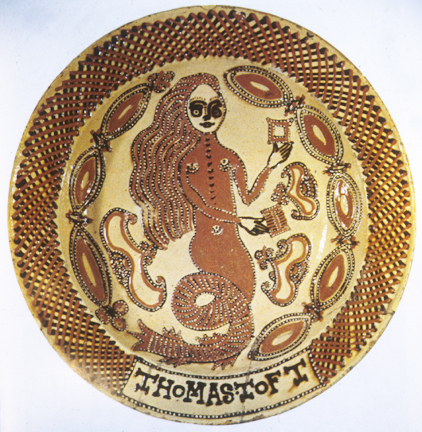The Staffordshire area of England is home to a pottery making industry dating to the 13th century. The area is blessed with rich local clay deposits and the Trent River served to transport raw materials and finished goods. The Trent River does not connect directly to the coast, but in the 1700's, an elaborate system of inland canals were built to connect the region to Liverpool, London and the coast for export. One of the most prolific of these locations in Staffordshire was Stoke-on-Trent, where in the 1600's brothers in the Toft family produced a line of tablewares. Using the slip trailing method, the brothers Ralph and Thomas created wheel thrown earthenware plates that are wonderful examples of the exuberant folk art style of naive painting. The Toft's are best known for their 'specials,' large platters made to commemorate special occasions, such as a wedding, a christening, or a coronation. They were intended to be displayed on a table or sideboard. The plates are around 18" in diameter and often feature a cross-hatched border made by trailing first a black slip in parallel, diagonal lines, and then, changing direction, parallel diagonal lines were trailed in a rich red-brown slip. The Tofts were not shy about signing their work either, and their signature often forms an important part of the design of the rim. The work of the Tofts is considered the best of this native slipware tradition.
This particular example is trailed with a drawing of a mermaid, with long, flowing hair and large eyes. She holds a comb in one hand, and a mirror in the other. Mermaids (and Mermen) represent classic zoomorphic creatures: half human and half fish, and their lineage can be traced back to the sirens of Greek mythology. Mermaids possessed magical powers, and loved music and singing. European folk tales record marriages between humans and mermaids, and according to the legends, as long as the man held the cap, or belt, or mirror, or comb of the mermaid, she could never leave him. However, as soon as she could find these objects, she could leave and return to the sea. There is usually an implied danger to humans from mermaids as they are known to entice men into the water after them, leading them to their deaths. The origin of the myth of the mermaid is thought by some to be the manatee, which suckles its young, human style, at the surface of the water. This may have led people to believe that these creatures were half human. Since our mermaid on this plate has her comb and mirror, one assumes she is ready to make her escape underwater.

Mermaid Plate, by Thomas Toft of Staffordshire
Slip Trailed Earthenware, 1675 CE


